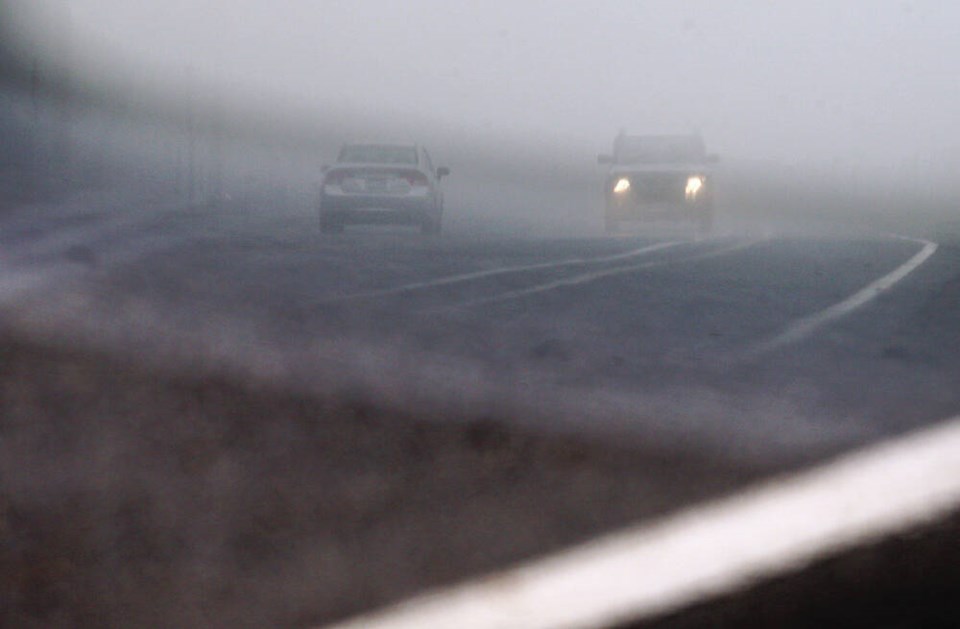We are well into the season where fog becomes a factor for safe driving. There’s already been a couple of “pea-soupers” around the Island in the past several days.
Fog can be deadly. Twenty-three years ago, 10 kilometres east of the Windsor, Ont., airport, on Highway 401, a dense patch of fog caused a chain reaction collision so devastating that it now has its own entry in Wikipedia.
A semi-trailer slowed as it entered a dense patch of fog, with visibility estimated at one point to be less than one metre. A series of other semis began jackknifing when they were unable to stop in time.
The fiery carnage that resulted saw eight people die with another 45 injured. Eighty-seven vehicles were destroyed. Fires broke out that were so intense that several car bodies were fused together.
Just this October, dense fog coupled with forest fire smoke blanketed the the I-5 freeway near Halsey, Oregon, causing a 60-car pile up. One person was killed and three more injured. It took emergency crews days to untangle then clean up the 45 passenger cars and 15-20 semi-trailers involved in the mayhem.
Driving in thick fog requires all the attention and skill you can muster. In a highway driving scenario with super thick fog, like the examples above, you are better to simply pull off the road somewhere safe and wait it out.
Most fog conditions, however, don’t mean you have to stop driving, but extra care is very important.
I’m amazed at the numbers of drivers who still fail to change their driving behaviour in bad weather. When visibility is decreased and stopping distances are increased — driving the way you would drive on a clear and dry street won’t cut it — no matter how good a driver you are.
Here are a few things that can make a big difference if you are caught in fog during your drive.
If you’re aware beforehand that there’s bad fog around, ask yourself if the trip is essential. The best defence is not to be out there when weather is going to push us beyond our own driving limits.
Make sure your lights are working. It’s not just about how far you can see. It’s equally important to be seen.
A reader emailed last week to complain about the number of drivers he encountered on the highway recently who had turned their headlights off in a fog spell. Those are dangerous choices because, while you might have a little better view ahead, no one else can see you.
B.C. law requires that headlights must be on a half before sunset and up to a half hour before sunrise. They also must be on when driving conditions restrict normal visibility. There are no exceptions for weather.
There’s always debate about fog lamps. Most experts agree that they are only legitimately required about 10% of the time. They are bright and often beyond annoying when they are beamed into the faces of oncoming drivers except under the right conditions, namely, fog.
While there is no specific rule saying when they are to be used, they must be properly mounted — no more than 30 cm below your headlights. When they’re turned on, the centre of the beam must project 10 cm below the height of the fog lamp itself. In other words they must be pointed low and kept out of the eyes of oncoming drivers.
Fog lamps shouldn’t be used simply because it’s dark out.
Using high beams in fog is a mistake. Bright lights reflect more against fog creating greater opacity and less visibility, and again, they are blinding to oncoming drivers.
Some people turn on their flashing hazard lights while still moving in fog. Most experts think this is a mistake. It can make other drivers believe you are stopped, causing them to turn or manoeuvre in ways that can cause collisions.
Never stop in a travel lane in fog. If you break down or must stop for some reason, get off the road as far as possible. Once there, flashing hazard lights are appropriate to warn approaching vehicles.
Fog is an accumulation of moisture. That means the roads are slippery. Your driving needs to be adjusted accordingly.
A slippery road should automatically remind us about that key safety element for bad weather driving — slow down. Speed isn’t always the reason for crashes. But the thought of that back end of a semi-trailer suddenly appearing out of the fog should be enough to make us all slow down.



